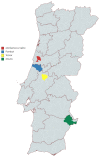First Report of Alphacoronavirus Circulating in Cavernicolous Bats from Portugal
- PMID: 37515207
- PMCID: PMC10384150
- DOI: 10.3390/v15071521
First Report of Alphacoronavirus Circulating in Cavernicolous Bats from Portugal
Abstract
The emergence of novel coronaviruses (CoVs) has emphasized the need to understand their diversity and distribution in animal populations. Bats have been identified as crucial reservoirs for CoVs, and they are found in various bat species worldwide. In this study, we investigated the presence of CoVs of four cavernicolous bats in six locations in the centre and south of Portugal. We collected faeces, anal, and buccal swab samples, as well as air samples from the locations using a Coriolis air sampler. Our results indicate that CoVs were more readily detected in faecal samples compared to anal and buccal swab samples. No CoVs were detected in the air samples. Phylogenetic analysis showed that the detected viruses belong to the Alphacoronavirus genus. This study represents the first report of Alphacoronaviruses circulating in bats in Portugal and highlights the importance of continuous surveillance for novel CoVs in bat populations globally. Ongoing surveillance for CoVs in bat populations is essential as they are a vital source of these viruses. It is crucial to understand the ecological relationships between animals, humans, and the environment to prevent and control the emergence and transmission of infectious diseases. Further ecological studies are needed to investigate the factors contributing to the emergence and transmission of zoonotic viruses.
Keywords: Alphacoronavirus; Portugal; cavernicolous bats; coronavirus.
Conflict of interest statement
The authors declare no conflict of interest.
Figures


References
-
- Bokelmann M., Balkema-buschmann A. Coronaviruses in Bats. Berl. Munch. Tierarztl. Wochenschr. 2021;134:1–16. doi: 10.2376/1439-0299-2020-44. - DOI
-
- Gloza-Rausch F., Ipsen A., Seebens A., Göttsche M., Panning M., Drexler J.F., Petersen N., Annan A., Grywna K., Müller M., et al. Detection and Prevalence Patterns of Group I Coronaviruses in Bats, Northern Germany. Emerg. Infect. Dis. 2008;14:626–631. doi: 10.3201/eid1404.071439. - DOI - PMC - PubMed
Publication types
MeSH terms
LinkOut - more resources
Full Text Sources

